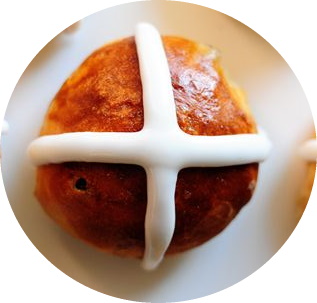By Lorie Lewis Ham
There are many things associated with Easter, including a lot of yummy food. One of the foods that some partake of this time of year has a very interesting history and symbolism for the season—Hot Cross Buns.
The buns are a spiced sweet bun usually made with fruit and marked with a cross on top, either with icing or etched into the dough. In many countries, they are traditionally eaten on Good Friday to mark the end of Lent, including parts of the United States and Canada. The cross represents the crucifixion of Jesus and the spices inside signify the spices used to embalm Him at His burial.
The origin of these buns is filled with mystery, with no one really knowing for certain where they came from. However, there are many theories and legends surrounding them. According to the website @Kitchn, one legend is that an Anglican monk created them in the 12th century to be eaten on Good Friday. There are also several stories that indicate that Hot Cross Buns were baked on Good Friday for superstitious reasons—some believed the buns carried magical or medicinal properties. They gained popularity in England towards the end of the 16th century when Queen Elizabeth I passed a law limiting the sale of sweet buns for only funerals, Christmas and Good Friday. Because they couldn’t buy the buns at other times, many people started secretly making them in their homes. According to Wikepedia, the first definite printed record of Hot Cross Buns comes from a London street cry, which appeared in Poor Robin’s Almanac for 1733 in which the buns are mentioned.
Another possible origin is found on the website Good Food Ireland. It states that even though they are inextricable linked to Easter and Christianity, they probably have pre-Christian origins. Cross Buns were baked to celebrate Eostre, a Germanic Goddess of Fertility, after which the season of Easter is said to be named. The four quarters of the cross on top of each bun were said to represent the phases of the moon, while the cross itself symbolized rebirth after winter. Even more interesting myths and traditions can be found on Smithsonianmag.com.
Through the years other versions of the buns have appeared, including coffee flavored ones in Australia, and toffee, orange-cranberry, salted caramel and chocolate and apple cinnamon versions in the UK. There is even a Not Cross Bun variation which is made the same way, but doesn’t include the cross.
Whatever its true history may be, in 2021 for many people Hot Cross Buns are still a symbol of the Easter season, but also a delicious treat to enjoy any time of year. If you have a special memory or special recipe for Hot Cross Buns that you would like to share with us, please share on our Facebook Page. Here is the recipe that Mennonite Insurance General Manager Jerry Linscheid grew up with:

Hot Cross Buns – Rosemary Moyer
Ingredients
- ¼ c. warm water
- 1 T. dry yeast
- 2 T. sugar
- 3 c. flour
- 1 ½ t. salt (less with margarine or salted butter)
- ½ t. cinnamon
- 1/8 t. nutmeg
- 1/8 t. allspice
- ¾ c. warm milk
- ¼ c. margarine, butter, or vegetable oil
- 1 egg, beaten
- ½ c. Zante dried currants, or chopped raisins
- ½ c. chopped walnuts
Directions
- Plump dried currants or raisins in 1 c. hot water (let sit at least 15 minutes).
- Dissolve yeast in water. Stir in 1 T. sugar.
- In large bowl, combine 1 ½ c. flour, 1 T. sugar, salt, and spices. Add yeast mixture to flour mixture.
- Add milk, margarine (oil/butter) and egg. Beat with mixer until well blended.
- Add more flour and mix with a spoon. Add plumped currants and nuts. Continue adding flour and stirring until soft dough is formed.
- Knead gently, until smooth, adding flour as needed and keeping dough soft.
- Let dough rise until doubled.
- Form round buns. Place on greased baking pan 12 per pan. Let rise until doubled.
- Bake at 375 degrees for about 10-15 minutes or until golden. In my oven, 5-6 minutes on the lower rack, and 3-4 minutes on the upper rack. Yield: about 24 buns. Let cool before decorating with a white icing cross.

